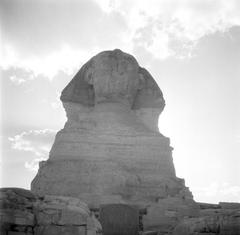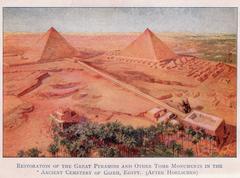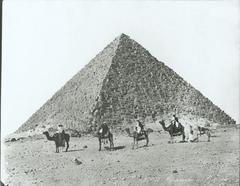Mohamed Nagy Museum Visiting Hours, Tickets, and Guide to Giza Historical Sites
Date: 04/07/2025
Introduction: The Significance of the Mohamed Nagy Museum in Giza’s Cultural Heritage
Nestled in Giza, Egypt, the Mohamed Nagy Museum is a testament to the enduring impact of Mohamed Nagy (1888–1956)—a founding figure of modern Egyptian art. Renowned for blending European Impressionist methods with distinctly Egyptian themes, Nagy’s innovative vision fostered a vibrant artistic dialogue between tradition and modernity. The museum, located in Nagy’s former studio and residence, provides visitors with an intimate glimpse into the artist’s life, creative process, and lasting legacy. This guide offers an in-depth look at the museum’s history, collections, practical visitor information, and its place within the broader context of Egyptian art and Giza’s historical attractions. For authoritative details, see the Egyptian Ministry of Culture Fine Art Sector, Touristlink, and Egyptian Monuments.
Table of Contents
- Introduction
- Mohamed Nagy: Early Life and Artistic Formation
- Artistic Influences and Notable Contributions
- The Mohamed Nagy Museum: History and Collections
- Planning Your Visit: Location, Hours, and Tickets
- Accessibility, Facilities, and Visitor Experience
- Guided Tours, Photography, and Museum Policies
- Nearby Attractions in Giza
- Frequently Asked Questions (FAQ)
- Practical Travel Tips
- Conclusion and Further Resources
Mohamed Nagy: Early Life and Artistic Formation
Mohamed Nagy was born on January 17, 1888, in Alexandria to an Egyptian father and Turkish mother. Immersed in a cross-cultural environment, he developed early interests in poetry, folk traditions, visual arts, and music. Nagy’s initial path led him to study law in Lyons, France (1906–1910), but his artistic calling ultimately brought him to the Academy of Fine Arts in Florence, Italy (1910–1914), where he was the first Egyptian student. Here, he absorbed Impressionist techniques and drew inspiration from artists such as Claude Monet, laying the groundwork for his signature fusion of European and Egyptian aesthetics.
Artistic Influences and Notable Contributions
Nagy’s art is characterized by a synthesis of Western technique and Egyptian subject matter. Profoundly influenced by ancient Egyptian murals, folklore, and the natural landscape, he developed a radical artistic approach after returning to Alexandria during World War I. His major creative phases include:
- Academic and Italian Period: Mastery of European color and composition.
- Abyssinian Expedition (1931): New motifs inspired by Ethiopian landscapes and culture.
- Egyptian Identity and National Themes: Iconic works like “Date Harvest,” “Moussa (Moses),” and “Nile Flood” depicting rural life and historical narratives.
As director of Alexandria’s Museum of Modern Art, Nagy also established the “Alexandria School,” influencing a new generation of Egyptian artists, including his sister, Effat Nagy.
The Mohamed Nagy Museum: History and Collections
After Nagy’s death in 1956, his studio in Hadayek El Ahram became the Mohamed Nagy Museum. Acquired by the Egyptian Ministry of Culture in 1962 and inaugurated in 1968, the museum began with a donation of around 40 oil paintings and sketches from Effat Nagy. Today, its holdings have grown to approximately 1,200 works, including paintings, sketches, murals, and personal artifacts. Noteworthy pieces include:
- “Egyptian Revival”: Awarded a gold medal at the Paris Salon.
- The “Alexandria School” Series: Illustrating Nagy’s masterful blend of Impressionism with Egyptian motifs.
- Personal Studio Artifacts: Offering insight into his creative process.
For more on the museum’s collection, refer to Fine Art Sector, Wikipedia, and Daf Beirut PDF.
Planning Your Visit: Location, Hours, and Tickets
- Address: 9 Mahmoud El Gendi Street, Al Haram, Giza, Egypt (Google Maps)
- Opening Hours: Tuesday to Thursday, Saturday, and Sunday: 9:00 AM – 4:00 PM. Closed on Mondays and Fridays (ibnbattutatravel).
- Ticket Prices: Entry is typically free. However, for some exhibitions or events, a nominal fee may be charged. For updated rates, see Nile Empire.
Note: Always verify hours and entry policies before your visit, as they may change during public holidays or Ramadan.
Accessibility, Facilities, and Visitor Experience
- Accessibility: The museum offers accessible exhibition spaces, but some areas may have limited wheelchair access due to steps.
- Facilities: Features include a library, a curated art store, clean restrooms, and seating areas. Bottled water is available, but there is no on-site café.
- Staff: Museum staff speak Arabic with some English; bilingual exhibit labels are provided.
Guided Tours, Photography, and Museum Policies
- Guided Tours: Available upon request. For in-depth understanding, private art-focused guides can be arranged through local operators.
- Photography: Non-flash, personal photography is generally permitted. Commercial photography requires advance approval.
- Etiquette: Refrain from touching artworks or leaning on display cases. Modest dress is advised out of respect for local customs.
Nearby Attractions in Giza
The Mohamed Nagy Museum is conveniently located near major Giza historical sites, including:
- Giza Pyramids and Sphinx: A UNESCO World Heritage site.
- Grand Egyptian Museum: Opening soon, featuring Egypt’s most comprehensive antiquities collection.
- Royal Chariots Museum and Temple of Khonsu: Further enrich your cultural itinerary.
For fans of modern Egyptian art, consider visiting the Mahmoud Mokhtar Museum and the Museum of Modern Egyptian Art in Cairo (Safarway).
Frequently Asked Questions (FAQ)
Q: What are the Mohamed Nagy Museum’s visiting hours?
A: Open Tuesday to Thursday, Saturday, and Sunday from 9:00 AM to 4:00 PM. Closed on Mondays and Fridays.
Q: How much do tickets cost?
A: Entry is usually free; check ahead for special exhibition fees.
Q: Is the museum wheelchair accessible?
A: Most exhibition spaces are accessible, but some galleries have steps. Contact the museum for specific accommodations.
Q: Can I take photographs inside the museum?
A: Yes, non-flash photography is permitted for personal use.
Q: Are guided tours available?
A: Yes, upon request or by booking through local tour operators.
Practical Travel Tips
- Getting There: Taxis are the most convenient; public transport is limited. Ride-hailing apps like Uber and Careem are reliable.
- Dress Code: Modest attire covering shoulders and knees is recommended (The Intrepid Guide).
- Safety: The museum is secure, but remain vigilant with personal belongings.
- Hydration: Bring bottled water and tissues for comfort.
- Tipping: Small tips for extra assistance are customary (10–20 EGP) (The Intrepid Guide).
- Language: Learn basic Arabic phrases for enhanced communication.
- Shopping: The museum’s gift shop offers authentic souvenirs; haggle in local markets outside the museum (The Intrepid Guide).
Conclusion
A visit to the Mohamed Nagy Museum offers a unique perspective on Egypt’s modern art movement and evolving cultural identity. With its extensive collection, visitor-friendly amenities, and proximity to Giza’s world-renowned sites, the museum is a must-visit for art aficionados, historians, and travelers alike. For the latest information on visiting hours, ticketing, and special events, consult the official Mohamed Nagy Museum page.
Enhance your experience by downloading the Audiala app for personalized guides, and explore our website for more resources on Egyptian art and travel.
References
- Egyptian Ministry of Culture Fine Art Sector
- Touristlink
- Egyptian Monuments
- Nile Empire
- The Intrepid Guide
- Daf Beirut PDF
- Safarway



